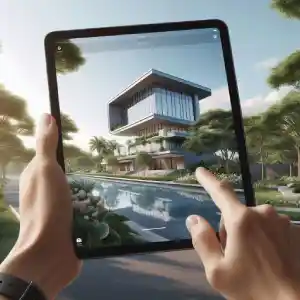
Android XR is a framework intended to make the next generation of immersive experiences possible. This framework will use the capabilities of Android devices to allow users to experience Augmented Reality (AR), Virtual Reality (VR), and Mixed Reality (MR). Android has been the king of smartphone operating systems for a long time, but the advent of XR technologies has brought forth the need for a specific version of Android to handle complex 3D environments, motion tracking, spatial interactions, and more. Today, XR platforms are becoming increasingly important for gaming, entertainment, healthcare, and many other industries.
This term is called XR, which stands for Extended Reality. XR consists of three: AR, VR, and MR. Each represents a different aspect of changing or enriching human perception of the real world with digital content. For example, AR adds virtual features to the real world; in VR, the user goes completely into a digital space; and in MR, the user interacts with a combination of both the virtual and real worlds.
Android XR is made up of both hardware and software. The hardware optimizes devices for XR experiences, featuring special sensors, displays, and processors. Software-wise, Android XR has a set of tools and APIs that aid developers in building immersive applications. These applications range from AR games and VR simulations to more complex MR experiences, so Android XR can be quite versatile for the building of next-gen digital content.
Its characteristics comprise the following:
Finding an Android XR application always carries a bit of challenge since, first and foremost, your perception of this system’s peculiarities implies the above-mentioned three key aspects: namely the issues of hardware specification, software architecture that is somewhat unique for its type, and that arsenal of tools and frameworks.
Hardware Requirements for XR
Android XR devices are hardware-focused to specifically meet the demands of XR applications. They are advanced in terms of sensors such as gyroscopes, accelerometers, and depth sensors that help them track movement, orientation, and depth. Most XR devices have high-resolution displays with better refresh rates. This reduces motion sickness and other adverse effects associated with lower refresh rates in user immersion. The GPU is crucial for rendering high-quality 3D content in XR applications. Modern Android XR devices are often accompanied by a high-performance GPU, thus capable of graphics-intensive workloads. Although the GPU and CPU are critical to the performance of XR applications, input methods for XR devices equally make interaction with the virtual world possible.
Some users respond to gesture-based controllers, while others prefer standard controllers. The most advanced devices employ voice or eye-tracking technology, which allows more intuitive interaction with virtual environments. Android XR is designed to handle the complexities inherent in generating immersive content and user experiences. The software stack is based on an Android operating system. Since Android is used as a basis for building XR applications, it’s somewhat intuitive for developers familiar with typical mobile development. Runtimes that handle specific forms of immersive content are situated above the Android OS.
This enables the creation of smooth AR, VR, and MR experiences because the hardware complexity is abstracted behind a consistent interface.
Android XR brings the entire set of frameworks and SDKs for developing 3D models, spatial interactions as well as real-time rendering. This includes among other key components ARCore for building AR Apps, Vulkan for creating low overhead graphics API as well as Sceneform for creating the 3D framework when building AR Applications.
XR APIs and Frameworks
Android XR also comes with a complete set of APIs and libraries for creating dynamic, interactive XR applications. These include the ARCore SDK, which provides tools for creating immersive AR experiences, contains motion tracking, environmental understanding, including flat surface detection, and light estimation-all aimed at making AR applications appear more realistic.
Android also has a wide acceptance of frameworks; for instance, Google VR and Daydream SDK for developing VR. They have been instrumental in assisting developers to create fully immersive applications in VR from games to 360-degree videos and other simulation types.
A combination of AR and VR into mixed reality development can be done using a combination of the Android XR APIs. It integrates Google’s MR SDKs with other third-party tools for the enhanced integration of real and virtual worlds to develop better interactive and complicated game mechanics.
Extended Reality: Developing Android Games
It is quite different and different type of tool and knowledge that one employs when compared to the process of developing the traditional mobile games while one is working about Android XR game development. Rendering graphics may not be the centre stage, yet the XR game would still relate to real-time tracking of user movements, interaction with 3D objects, and seamless virtual experience creation.
Tools and frameworks in game development
The two most widely used game development engines are Unity and Unreal Engine for Android XR. These both support the full cycle of XR development and are tightly connected with Android XR APIs. In this regard, Unity comes along with special tools and libraries specifically designed to develop AR and VR applications. The latest Unity’s XR Interaction Toolkit is a collection of ready-to-use components that makes building interactive objects, teleportation mechanisms, and user interfaces in the context of XR environments easier and faster.
Unreal Engine, however is characterized by high graphical capability to provide the users with a comprehensive experience. Support for ARCore and other Android XR technologies in Unreal Engine creates photorealistic virtual environments, though accessible only in virtual reality.
Development kits and SDKs
Installation of required SDKs and setup of the development environment is the first. AR demands obligatorily the use of an ARCore SDK with such a set of tools to perform motion tracking, detection of surfaces, and location of virtual objects into the real world. For this case in developing a game in VR, it obligatorily demands Google VR SDK, but probably Daydream SDK also to access such features like the control of movements and specially prepared interfaces for use within VR.
These SDKs are integrated into the most popular game development engines, such as Unity and Unreal Engine. Therefore, implementing XR games has never been so efficient and easy. Useful features provided by SDKs include performance optimization tools, debugging utilities, and documentation to direct developers in their workflow.
Development Process
There are very important steps in the process of developing an Android XR game that involve: setting up of the development environment, designing, implementing, testing, and deployment.
Setting up the Development Environment
The first step in creating an Android XR game is setting up the development environment. That means having Android Studio, the official IDE for Android development, SDKs for AR and VR development, and, if one chooses to use one of those, installing either Unity or Unreal Engine.
Integration of both the Android XR SDKs with relevant libraries on either Unity or Unreal will certainly help the developers get up and running fast by developing their very first experience in XR. Successful and good-setting-up of the Android Emulator must be necessary for testing the compatibility in cross-platforms-; meaning, playing the games through virtual devices. The hardware-in physical form-of the genuine Android XR must additionally serve to test the game for real.
First Android XR Game
Having installed the environment, developers can move ahead to start building their first game. The development flow for an XR game closely mirrors that of a traditional game- mechanics definition, asset creation, interactivity implementation, and performance optimization.
This includes simple interactions, such as tracking environments to place virtual objects appropriately in an augmented reality game and the development of fully immersive environments in virtual reality games using navigational aids, such as controllers or head tracking technologies. There also is a huge need for user interface and user experience design in both types of games: the controls need to allow gameplay and have to seamlessly work across a wide range of devices.
Testing is the most critical step in developing an XR game. Unlike other forms of media, XR experiences often suffer more from motion sicknesses, latencies, and graphic glitches. So, there is a great need to test and retest such XR hardware such that the game runs well and does not show errors in performance. XR games could be further required to monitor the sensor data and optimize their rendering technique so that their game work well with different types of lighting used in an AR game.
Multiplayer and Social Integration
Modern XR games typically support multiplayer. This requires robust networking techniques to enable the interactional participation of real-time players in a shared virtual space. Google Cloud, Firebase, and other such services can be used to host multiplayer games and help match participants.
These features can be complemented with social integration factors, including other social integration factors such as multiplayer elements. Some of the additional factors may include voice chat, avatars, and leaderboards. The developer provides APIs such as Facebook or Google Play Games Services for such integration.
Challenges in XR Game Development
Though much advancement is seen in this area of Android XR technology, game developing within the domain is a technological issue- starting from hardware complications to issues about user experience.
Technological Challenges
A good challenge in developing XR games lies in ensuring high performance; XR applications require a frame rate high enough to provide smooth experience while maintaining low latency. All this requires developers to ensure that 3D models are optimized, textures and effects are optimized to avoid causing stutter or lag. Moreover, XR games have to be monitored in real-time. This is highly computation-intensive and necessitates effective handling of sensor data. Latency is quite critical since a very slight delay might result in discomfort to the users, particularly on VR.
UX/UI Challenges
Another challenge is designing intuitive user interfaces for XR. Since XR involves immersion, most 2D interfaces won’t do. There needs to be the design of UI elements that will feel normal in a 3D space. Motion sickness in VR also arises when there’s no sync between head movements and virtual space. One needs to make sure the game mechanics won’t trigger any discomfort during play. It should all be done within hardware compatibility.
The XR devices have many capabilities that vary. Thus, the developers will have to test if their games work on a different type of Android XR. This is because processing, sensors, and display technology are not the same and would therefore lead to different performance outcomes. These should be considered by the developer as they optimize the game. Future of Android XR and Game Development The latest development that has just occurred is most likely to unlock more possibilities in the near future for developers who work with Android XR. Hand tracking, full body avatars, and eye tracking will lead the world to new ways of interacting with XR content. The next development will be in mixed reality, which creates more interactive and complex game mechanics that blur the real and virtual worlds. It also will be cloud-gaming, making developers’ games more accessible to a greater audience.
Android XR is evolving fast and still shows immense promise for highly interactive experiences with high immersion. Awareness of critical components of Android XR coupled with the right tool sets in development, and coupled by adherence to the best practices for performance as well as usability can get developers to create highly entertaining AR, VR, or MR games. The XR game development landscape is poised to shine, with continually emerging new technologies that continue making the experiences more lifelike, engaging, and accessible to users on the planet. Latest Android XR versions have tremendous scope for innovation in the development of next-generation games. Whether they develop new AR games or build highly complex virtual reality simulations, Android XR gives the developer all the tools necessary for developers to complete tasks they would otherwise not be possible within the confines of immersive games.







